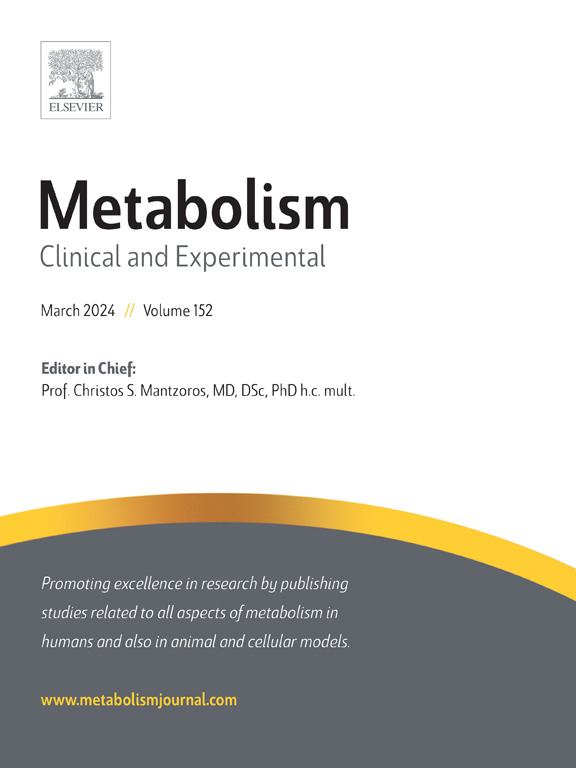Protein oxidation in non-exercising healthy adults under varying dietary conditions: Physiological determinants, effects on fuel partitioning, and implications for body weight regulation
IF 10.8
1区 医学
Q1 ENDOCRINOLOGY & METABOLISM
引用次数: 0
Abstract
Background
Protein oxidation (PROTOX) typically accounts for the smallest fraction of daily energy expenditure (24hEE) in humans compared to carbohydrate and lipid oxidation. However, inter-individual differences in PROTOX may explain differences in fuel partitioning and body weight change. We aimed to elucidate the physiological determinants of PROTOX under controlled 24-h dietary conditions, including eucaloric feeding, fasting, and overfeeding diets with variable protein content.
Methods
Eighty-six weight-stable healthy volunteers with normal glucose regulation (67 M/19F; age: 37 ± 10 years; BMI: 26.7 ± 4.5 kg/m2, body fat by DXA: 29.0 ± 9.8 %) underwent 24hEE measurements by whole-room calorimetry during energy balance (20 % protein, 50 % carbohydrate), different overfeeding diets (200 % of the daily eucaloric requirement), including three normal-protein (20 %) diets (balanced: 50 % carbohydrate; high-carbohydrate: 75 % carbohydrate; high-fat: 60 % fat), low-protein (3 %) and high-protein (30 %), and 24-h fasting in a randomized crossover design. Urine samples were collected during each 24-h dietary intervention for quantification of PROTOX and catecholamine excretion rates by nitrogen excretion and high-performance liquid chromatography, respectively.
Results
PROTOX during energy balance (mean ± SD: 372 ± 78 kcal/day) was positively associated with protein intake (r = 0.39, p < 0.001), fat free mass (r = 0.35, p < 0.001), but not with fat mass (p = 0.24). Higher PROTOX was associated with higher 24-h urinary norepinephrine (partial r = 0.27, p = 0.01), but not epinephrine (p = 0.48), excretion rates. During normal-protein diets, higher PROTOX was associated with lower lipid oxidation, but showed no association with carbohydrate oxidation. Inter-individual variability in PROTOX did not predict changes in weight or body composition over two years.
Conclusion
Dietary protein content, lean body mass, and sympathetic nervous system activity are key determinants of PROTOX. Although PROTOX did not predict free-living weight gain, increased PROTOX is associated with decreased lipid oxidation, underscoring its role in fuel partitioning and whole-body energy and substrate balance.
不同饮食条件下不运动的健康成人的蛋白质氧化:生理决定因素,对燃料分配的影响,以及对体重调节的影响
与碳水化合物和脂质氧化相比,蛋白质氧化(PROTOX)通常占人类每日能量消耗(24hEE)的最小比例。然而,PROTOX的个体间差异可能解释了燃料分配和体重变化的差异。我们的目的是阐明在控制24小时饮食条件下PROTOX的生理决定因素,包括高热量喂养、禁食和不同蛋白质含量的过度喂养。方法86例体重稳定、血糖调节正常的健康志愿者(67 M/19F;年龄:37±10岁;BMI: 26.7±4.5 kg/m2, DXA体脂:29.0±9.8%)在能量平衡(20%蛋白质,50%碳水化合物),不同的过度喂养日粮(200%的日热量需求),包括三种正常蛋白质(20%)日粮(平衡:50%碳水化合物;高碳水化合物:75%碳水化合物;高脂肪:60%脂肪),低蛋白(3%)和高蛋白(30%),以及24小时禁食。在每24 h饮食干预期间收集尿液样本,分别用氮排泄法和高效液相色谱法定量测定PROTOX和儿茶酚胺的排泄率。结果能量平衡期间的protox(平均±SD: 372±78 kcal/day)与蛋白质摄入呈正相关(r = 0.39, p <;0.001),无脂质量(r = 0.35, p <;0.001),但与脂肪量无关(p = 0.24)。较高的PROTOX与较高的24小时尿去甲肾上腺素排泄率相关(部分r = 0.27, p = 0.01),但与肾上腺素排泄率无关(p = 0.48)。在正常蛋白质饮食中,较高的PROTOX与较低的脂质氧化相关,但与碳水化合物氧化无关。PROTOX的个体间变异不能预测两年内体重或身体组成的变化。结论膳食蛋白质含量、瘦体重和交感神经系统活性是影响PROTOX发病的关键因素。虽然PROTOX不能预测自由生活体重增加,但增加的PROTOX与脂质氧化降低有关,强调其在燃料分配和全身能量和底物平衡中的作用。
本文章由计算机程序翻译,如有差异,请以英文原文为准。
求助全文
约1分钟内获得全文
求助全文
来源期刊

Metabolism: clinical and experimental
医学-内分泌学与代谢
CiteScore
18.90
自引率
3.10%
发文量
310
审稿时长
16 days
期刊介绍:
Metabolism upholds research excellence by disseminating high-quality original research, reviews, editorials, and commentaries covering all facets of human metabolism.
Consideration for publication in Metabolism extends to studies in humans, animal, and cellular models, with a particular emphasis on work demonstrating strong translational potential.
The journal addresses a range of topics, including:
- Energy Expenditure and Obesity
- Metabolic Syndrome, Prediabetes, and Diabetes
- Nutrition, Exercise, and the Environment
- Genetics and Genomics, Proteomics, and Metabolomics
- Carbohydrate, Lipid, and Protein Metabolism
- Endocrinology and Hypertension
- Mineral and Bone Metabolism
- Cardiovascular Diseases and Malignancies
- Inflammation in metabolism and immunometabolism
 求助内容:
求助内容: 应助结果提醒方式:
应助结果提醒方式:


